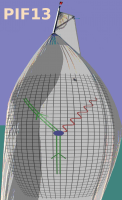Speaker
Naoto Tanji
(IPhT Saclay/ KEK)
Description
A high-energy nucleus can be viewed as a condensed state of high-density and weak-coupling gluons, which is called color glass condensate. After a collision of heavy nuclei, these gluons are emitted between the two nuclei and they can be interpreted as coherent classical chromo-electromagnetic
fields polarized in the longitudinal beam direction. The strength of these fields is given by the scale Q_s, which characterize the gluon saturation phenomena in high-energy nuclei, and typically is the order of 1 GeV^2. As two nuclei recede from each other after the collision, these fields extend to the longitudinal direction with nearly the speed of light. In the transverse direction, these fields have a random distribution with a coherence length characterized by the scale Q_s.
To investigate quark production from such inhomogeneous classical fields, we employ a Monte Carlo technique, which enable us to simulate the real-time dynamics of quantum fields interacting with a background classical field with a cheaper numerical cost compared with another method. We will show the results of numerical calculations in which realistic configurations of the color gauge fields in heavy-ion collisions are taken into account.
Author
Naoto Tanji
(IPhT Saclay/ KEK)

